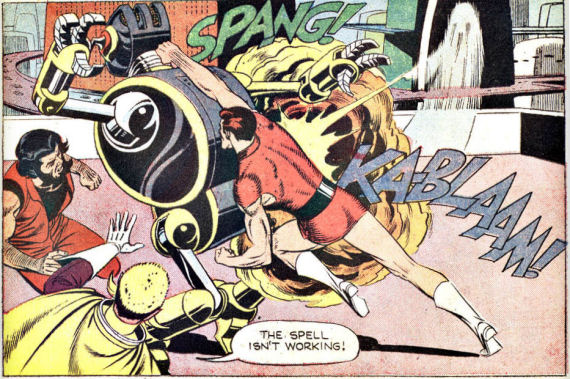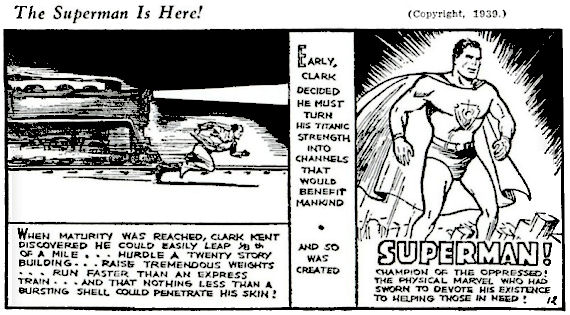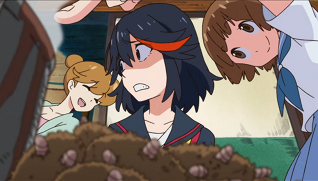By the way, in the first part of this article (part 1) I referred to Winsor McKay’s Little Nemo; I should have said that the proper name for the strip is Little Nemo in Slumberland. I hope you’ve gone to the GoComics link and are enjoying the strips. I sure am. I also want to emphasize that—since the U.S. strips are all I saw—this article deals only with those strips that appeared in the U.S. (and, probably, Canada).

So, as I said, the strips went from all funnies to including action/adventure some time in the ‘20s; both Tarzan of the Apes and Buck Rogers—both, as you probably know, based on books; the former by Edgar Rice Burroughs, the latter by Philip F. Nowlan—started on January 7, 1929. Leaving aside the question of whether Tarzan is a hero for the modern age (there is no question that Burroughs had racist material in the books, although he did not write the comic strips), Tarzan was kind of a low-key hero, living in the jungles of Africa. Raised by—not apes, but a kind of more intelligent cousin of the great apes—Tarzan’s adventures had him (in the books, at least) going from Africa to England where, as John Clayton, Lord Greystoke, he acquired a “thin veneer of civilization” which he could quickly discard as the situation required. The ability to converse with animals (à la Doctor Doolittle, one presumes), swing from tree to tree, and not be bound by convention must have struck some kind of chord in the breasts of comic readers, for the series continued with original strips until 1972; since then, they have been reprints.

Originally drawn by Hal Foster (of Prince Valiant fame), Tarzan has been drawn by various artists; my favourites being (in no particular order) Burne Hogarth, Russ Manning and Mike Grell. As you can probably tell from Figure 1, Hogarth was a “fine” artist more than a “comic” artist—his books on figure drawing, anatomy and so on are considered classics of the field. Contrast with Figure 2, which is more fluid and comic-y, drawn by Russ Manning. (Manning’s Magnus, Robot Fighter was one of my favourite comics in the sixties, mainly because of his drawing style. See Fig. 3)
Other adventure-type strips debuting in 1929, which I’m not going to cover here, were Captain Easy, by Roy Crane, and Tintin (in Belgium) by Hergé (Georges Remi). (Little Orphan Annie, which was both adventure and social commentary, in my opinion, had debuted five years earlier.) The majority of action strips, however, came about in the ‘30s, like The Lone Ranger, The Phantom, Mandrake the Magician and so on. The biggest strip published in 1929 was Buck Rogers—in terms of both longevity and spin-offs.

Buck Rogers—as readers of Amazing probably already know—was first published in Amazing in 1928 as a character (named “Anthony,” not “Buck”) in Nowlan’s Armageddon 2419 A.D.; Nowlan quickly got it turned into a strip illustrated by Dick Calkins in 1929, as I’ve said—though from Figure 4, it looks like they changed the year of Armageddon. Rick Yager took over drawing the strip in about 1932, and it, too—like all long-running strips, adventure or not, has had a succession of artists. (Incidentally, according to Wikipedia, Nowlan told Buckminster Fuller that some of the strip’s science was drawn from material published by Fuller. Maybe that’s the reason his name changed?) Yager hired assistant artists to help work on the strip after Nowlan ceased involvement with it, and they had a blow-up with the comics syndicate in 1958, leaving the strip. It was then taken over by Murphy Anderson, then George Tuska, who drew it until it ceased publication in 1967. Later, the strip was revived by Gray Morrow and Jim Lawrence in 1980, and renamed Buck Rogers in the 25th Century, probably to coincide with the TV series of the same name which—although it’d had a short run in 1950 and 1951—had been revived and brought up to date in 1979, starring Gil Gerard, Felix Silla and Erin Gray. In 1981, Cary Bates took over the strip, which ceased publication in 1983.

In an odd coincidence—or maybe not so odd—a character created to play off the popularity of Buck Rogers, Flash Gordon, written and drawn by Alex Raymond, debuted exactly five years to the day after Buck’s strip did. In what I consider a strange twist of fate, almost everyone knows about Flash Gordon thanks to the Buster Crabbe serials if nothing else, but aside from the TV show, I doubt that Buck is as well-known these days, in spite of inspiring one of the most disparaging descriptions of all time given to science fiction (which I’m guessing everyone has heard): “That crazy Buck Rogers stuff.”
To keep this article down to two parts, we’ll skip over much of the ‘thirties. Moving on to the feature superhero—one of my two favourites of all time—we come to a guy who wanted to appear in the newspaper comic strips, but was turned down in February 1937 by United Feature Syndicate. His authors had been trying for years to sell him as a strip, with no luck at all, until suddenly his creators were told to change their 4-panel strips into an 8-panel page suitable for publication in a book! They did so, more or less, and in June, 1938, Action Comics #1 introduced Superman to the world!
Okay, yes, I’m biased—I grew up on Superman, from the time I returned to the United States from England (which would have been 1953-ish… my memory’s a bit unclear about things that happened to me when I was six and under); when in England my superhero was an “ordinary” space jockey named Dan Dare! But I must have been introduced to “Supes” just about the time I returned to the U.S.
Which is kinda funny, because all my under-18 life in the U.S., my mother was dead set against superhero comics (we won’t talk about my smallish E.C. comic collection in Duluth, Minnesota, which she found in my room and promptly destroyed, thanks to Dr. Fredric Wertham—see 1954’s Seduction of the Innocent (Figure 4)—parroting Dr. Wertham’s claim that Superman was the Nietzschean Übermensch, and therefore somehow a Nazi. Likewise, Batman and Robin were closeted homosexuals—and in my family, homophobia was alive and well: my father never hugged me, or patted me on the back (literally or figuratively) for fear of being thought “a faggot.” Because that was how he was raised; I’m sure my grandfather was rougher on him than he was on me. (Of course, when it became okay to be gay, so to speak, a lot of gay men embraced the possibility that B&R were in fact gay. I’m not sure if this is a case of art imitating life or vice versa.)

But apparently I still hungered for superheroes. In fact, when we lived in Duluth, Minnesota, in about 1954 or so—when I would have been seven years old—I invented my own superhero, and named him “Black Hoof.” You see, his superpower was that he could turn into a superpowered, flying black horse! (I even designed a costume—on paper—of green and black with a circled logo of a black hoof [what else?]) And I was often seen around our neighbourhood wearing a green towel as a cape, and leaping off doghouses and the like. (That was in the days when there wasn’t the kind of gang violence that afflicts larger cities these days; likewise, parents weren’t deathly afraid that their kids would be snatched by pedophiles, so we pre-schoolers went more or less where we wanted in our neighbourhoods.) Never did manage to learn how to either change into a horse or fly.
“Kids’” comics were okay, though; we had more than our share of Little Lulu, Dell Gold Key (and we snuck in Tarzan and Red Ryder and so on), Disney comics and so on. In actuality, though, one superhero was allowed in our house—and that was C.C. Beck’s Captain Marvel (today usually called Shazam! to differentiate him from the Marvel creation of the same name, SHAZAM being the magic word made from the initials of the heroes that “made” him Captain Marvel instead of Billy Batson, crippled newsboy); he was drawn in a “comic” style rather than a realistic style—one of his chief foes was some kind of caterpillar, f’cryin’ out loud!—and the Big Red Cheese (as his fans often affectionately called him) was a welcome and frequent guest in our house! (Later, as preadolescent hormones began to stir, Mary Marvel was scrutinized a lot too by yours truly.) But even when I was a teenager in high school, bringing home the DC comic line—and the Marvel line when Spiderman began to make a splash—of superheroes (even heroines, like Wonder Woman and Supergirl) was frowned upon.
But Superman continued to be “my guy.” I’m not sure why George Reeves as Superman, on the TV show of the same name, was allowed in our house, but I watched him faithfully. As a daily newspaper strip, Superman began in January 1939, adding a Sunday strip in November of that year. By the time the strip ended in 1966, readership was estimated at over 20 million!

A number of different writers and artists worked on the Superman strips, starting with Joe Shuster, but as Superman became more popular, Shuster hired assistants. Paul Cassidy, the first in a line of ghost artists on the strip began inking in 1939, but Leo Nowak replaced him in 1940. At least five other assistants (pencilers and inkers) worked on Superman dailies and Sunday strips during the pre-World-War II period. Often, the strips during this early period of shop work were a team effort; multiple artists worked on different parts of the same strip.

World War II changed all that. Jerry Siegel—the main writer—was drafted in 1943; at least two other “shop assistants” were too. Wayne Boring, who had been another Shuster “assistant,” left the Shuster studio draw the daily strip himself for DC; Boring and another artist, Stan Kaye, dominated the daily strip’s artwork throughout most of the 1940s, also drawing the Sunday strip between 1940 and 1966. (Boring was also to draw many of the Superman comic books.)

As you can tell from looking at the drawings in Figures 8 and 9, Boring’s comic book Superman had a long chin (rather like Dan Dare), while Curt Swan’s was more naturalistic. At the times the artists changed, I doubt that many readers really noticed the difference. But changes were coming to the whole Super-family, and comics were beginning to morph into something maybe more meaningful. (By the way, when I speak of “Super-family,” I’m not kidding. By the ‘70s, I think we had not only a Superman, but a Bizarro Superman from a parallel cubical Earth; a Supergirl—his cousin from the bottled miniaturized city of Kandor; Krypto, the super dog; Superboy—stories taking place before Superman was an adult; a Super-monkey—memory has drawn a merciful curtain over whatever that was about; and, if I remember correctly, a super horse! Heavens to Murgatroyd!

Since we’ve already transitioned to comic books, I’ll be talking about those—all in the pre-“graphic novel” days—from here on. Naturally, during all those years, other super-powered people were published—in both newspaper and comic book form, to challenge the mighty Kryptonian; and some were made by the same company and some by rival companies. Sure, I flirted with a number of them in the ‘60s; I read The Flash, Batman and Robin, Green Lantern, Green Arrow (with Speedy!), Blackhawk, Supes’ friends Lois Lane and Jimmy Olson, the Justice League of America, and so on; but I kept faith with Superman. When Marvel started gaining traction in the ‘60s, with (in no particular order) Spiderman, Thor, Iron Man, The Hulk, Doctor Strange, Daredevil, Sgt. Fury and his Howling Commandos, Black Panther, Luke Cage and so on… I almost jumped ship and went over to the dark… er, Marvel side. After all, Spiderman was a lot like me… brainy, not terribly athletic, sometimes picked on by the athletic kids—and he became a super-hero! But sanity prevailed—besides, I started hanging out with “normal” kids as well, instead of just the “brainiacs,” as we/they were sometimes called. Besides, my best friend, Darrell Wilcox, was smart as well as strong, and had his own car—and then got a motorcycle! My role models were changing.
Besides, the sixties were half over when I graduated from high school—let’s hear it for the Everett (Washington) High School Seagulls!—and went into the US Navy. Superheroes had to take (at a minimum) second place; I’d learned all kinds of information, and now it was time to learn about “real life,” as some people call it. I stopped needing superheroes—but I still get a kick out of reading Superman.
How about you? What’s your story? Who’s your favourite superhero and why? I’d like to hear it.
I hope you’ve registered on Amazing Stories and are subscribed to my column; if not mine, I’m sure you can find something you’ll enjoy even more. If you have anything to say about this week’s column/blog entry, and you’re registered, go ahead and comment—tell me the answer to the above question. If you haven’t already registered—it’s free, and just takes a moment—then register/comment here; or comment on my Facebook page, or in the several Facebook groups where I publish a link to this column. I might not agree with your comments, but they’re all welcome, even if you don’t agree with my opinion. It is, as always, my own opinion, and doesn’t necessarily reflect the views of Amazing Stories or its owners, editors, publishers or other bloggers. See you next week! (A major amount of material in this blog was taken/cribbed from Wikipedia. Credit where credit is due….)










